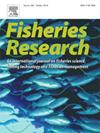Flume tank trials to investigate the snagging of towed demersal fishing gears on boulders
IF 2.2
2区 农林科学
Q2 FISHERIES
引用次数: 0
Abstract
The snagging of towed demersal fishing gears on seabed features and obstructions can have economic, safety, ecological and environmental consequences. Nevertheless, very little is known about the snagging process, the extent to which it occurs and how best to mitigate it. Here we present the results of a systematic flume tank study to investigate which gear-types are more likely to snag on boulders, which part of a given gear snagging is more likely to occur, and what are the characteristic features of the boulders shapes and size that increase the likelihood of snagging. As a case study we focus on gears that are typical of Jammerbugt, Denmark and show that tickler chain beam trawls are more likely to snag, while the snagging likelihood of the otter trawl, Danish seine and chain mat beam trawl are similar. Our approach and the methodology we develop will help design safer and more sustainable gears that interact less with the seabeds habitats and features. They will provide insights as to which gears can be used on which fishing grounds, contribute to a reduction of abandoned, lost and discarded fishing gears (ALDFG), improve fisher safety, and help fisheries managers develop measures that will promote more environmentally friendly and sustainable fisheries.
水槽试验,以调查拖曳的海底渔具在巨石上的阻力
拖曳底栖渔具在海底特征和障碍物上被钩住可能会产生经济、安全、生态和环境后果。尽管如此,人们对这个过程、它发生的程度以及如何最好地减轻它所知甚少。在这里,我们展示了一项系统水槽研究的结果,以调查哪种齿轮类型更容易在巨石上卡住,给定齿轮的哪一部分更容易发生卡住,以及巨石的形状和大小的特征是什么,增加了卡住的可能性。作为一个案例研究,我们将重点放在丹麦Jammerbugt的典型齿轮上,并表明挠性链梁拖网更容易受阻,而水獭拖网,丹麦围网和链垫梁拖网的受阻可能性相似。我们开发的方法和方法将有助于设计更安全、更可持续的齿轮,减少与海床栖息地和特征的互动。它们将提供关于哪些渔具可以在哪些渔场使用的见解,有助于减少遗弃、丢失和丢弃渔具(ALDFG),提高渔民的安全,并帮助渔业管理人员制定措施,促进更加环境友好和可持续的渔业。
本文章由计算机程序翻译,如有差异,请以英文原文为准。
求助全文
约1分钟内获得全文
求助全文
来源期刊

Fisheries Research
农林科学-渔业
CiteScore
4.50
自引率
16.70%
发文量
294
审稿时长
15 weeks
期刊介绍:
This journal provides an international forum for the publication of papers in the areas of fisheries science, fishing technology, fisheries management and relevant socio-economics. The scope covers fisheries in salt, brackish and freshwater systems, and all aspects of associated ecology, environmental aspects of fisheries, and economics. Both theoretical and practical papers are acceptable, including laboratory and field experimental studies relevant to fisheries. Papers on the conservation of exploitable living resources are welcome. Review and Viewpoint articles are also published. As the specified areas inevitably impinge on and interrelate with each other, the approach of the journal is multidisciplinary, and authors are encouraged to emphasise the relevance of their own work to that of other disciplines. The journal is intended for fisheries scientists, biological oceanographers, gear technologists, economists, managers, administrators, policy makers and legislators.
 求助内容:
求助内容: 应助结果提醒方式:
应助结果提醒方式:


